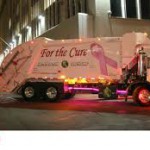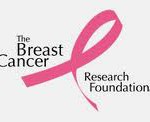October is often a beautiful fall month. It’s also my birthday month. But I learned early in my tenure at Breast Cancer Action to dread the month because everything turned pink. I had hoped that when I stepped down from my job, I could get back to having October just be a month. But once a breast cancer activist, I guess always one. So I still feel inundated in October.
Pinktober
This month has so far been no exception. It’s hard to decide what the worst offender was among the things that turned pink this month. Was it the garbage truck for the cure in
New York City? Was it the oil rig painted pink? Was it the Lord & Taylor “Pink Carpet of Beauty?” Was it American Airlines (the only airline currently losing money) Fly for the Cure effort? Or was the winner the pink cleats on those NFL football players as they pummeled each other on a recent Sunday? Or maybe it was the Komen for the Cure
Foundation’s “Promise Me” perfume, laced with a lot of ingredients that are known to increase the risk of cancer (you
can act to stop this one at http://thinkbeforeyoupink.org/).
Maybe you have a favorite in the “how low can we go with pink” contest. If you do, send to Breast Cancer Action so it can be used in the organization’s Think Before You Pink campaign.
A Ray of Sanity from the New York Times? Sadly Not.
I don’t read the Sunday New York Times in October or any other month. I won’t spend the kind of time it requires to read it carefully. I figure that if there’s a important article in it, a friend will tell me about, or I’ll stumble on it in the iPad New York Times app. But, probably because of my background, I did quickly find an article published by the Times on October 15 which gave me a little hope that we would finally have an in-depth investigative report about the pinking of America. After all, the new (and first female) executive editor of the paper says she’s dedicated to having more investigative reporting.
Entitled “Welcome, Fans, To the Pinking of America,” the article by Natasha Singer appeared, appropriately enough, as the lead story in the paper’s business section, So far, so good. And early on there are acknowledgements that not everyone likes the pinking of everything. But it becomes quickly clear that the article is about how successful the Komen
Foundation has been in making breast cancer into a multi-billion dollar marketing opportunity to support mammography screening and breast cancer education, and not about how this effort has left most of the public completely in the dark about the realities of breast cancer.
The article quotes Nancy Brinker, the founder of Komen as follows: “It’s a democratization of a disease. It’s drilling down into the deepest pockets of America.” So this is what democracy means, getting money out anyone you can find? Funny, I thought it meant people participating in the political process by which decisions that affect their lives are made. How did we get to this?
I blame the Komen Foundation, the leading but not the only beneficiary of products sold with pink ribbons on them. It is Komen that has, in the article’s words, “rebranded an entire disease by putting an upbeat spin on fighting it.” And it’s done that by marketing, and by drilling into the buying public messages that are wrong-headed in the extreme. Those messages range from how much progress has been made in breast cancer to how mammograms are all anyone needs to know about breast cancer.
One thing that the New York Times article makes clear is that, while consumers are encourage to buy products to support breast cancer research, Komen spends twice as much on education as it does on research. So if you think that by buying pink you’re funding research, think again.
I won’t attempt to summarize the rest of the New York Times article, since it mostly a promotion of Komen’s approach. While it mentions that Komen’s message may oversimplify breast cancer issues, it hardly says why or how.
Words from Komen: Same Song, Different Verse
While Pinktober was raging and the buying opportunities mounted, I was the unhappy recipient of a fundraising letter from Komen. Seems the millions that the Foundation raises from corporate partnerships isn’t enough, so they do a lot of direct mail. The letter contains the following statements:
— Komen funds “research dedicated to conquering breast cancer at every stage – from the causes to the cures”
— “Our single minded focus [is] on finding the cures”
— “We’re working 24/7 to find the cures for breast cancer
— “Imagine life without breast cancer.”
Most of the letter focuses on how much Komen funding has accomplished and how Komen is going fund the cures for breast cancer if I write a big check (not). But what does it mean
to “imagine life without breast cancer”? I don’t know how I can do that with so few resources devoted to finding and eradicating the causes of the disease. And while the letter mentions in passing that Komen funds this kind of research, I know for a fact that it is a very small part of the Foundation’s portfolio, and that they ignore many of the findings that come from that research. The Foundation’s information about environmental links to breast cancer is flat out wrong in a lot of places.
At the invitation of someone associated with an organization called the Breast Cancer Sisterhood, Komen agreed to respond on a blog hosted by the Sisterhood to questions and criticisms raised by others in the breast cancer “community.” The person who wrote on behalf of Komen is the “Director of Marketing and Communications.” Though there was supposed to be a give and take with the Komen representative, she (the Komen rep) posted one message defending Komen and failed to answer many questions. As far as I can tell she hasn’t responded to subsequent comments. Read it yourself by following the link. So much for dialogue.
And Komen is not alone in claiming the ground of funding all the progress in breast cancer.
The Breast Cancer Research Foundation (BCRF) took out a couple of full page ads in the New York Times to tell people how so much of the progress in breast cancer it has funded. It reads a lot like Komen’s claims. Of particular note to me is that much of the funding for BRCF comes from not just pink products but directly from the Estee Lauder Companies. They make cosmetics and they founded BRCF, which is committed to “prevention and a cure in our lifetime.” The first part will be particularly tricky so long as Estee Lauder refuses to sign the compact for safe cosmetics and continues to use toxics in their products. Hypocrisy? You betcha.
Seems all the big players use Pinktober to cover up one thing or another about breast cancer.
A Word About Mammograms
Since Komen thinks everyone should get a mammogram, and that’s all they talk about in October, a couple of things of note on this topic.
Just as the month was drawing to a close, a new study was issued that shows that mammograms result in a great deal of overtreatment, and actually only help at most 13% of women whose breast cancer is found by mammogram (that’s about 18,000 women per year of the 138,000 diagnosed by mammograms. I could go into a long explanation about why this is true, but Breast Cancer Action has already done a pretty good job of explaining it. Take a look at the organization’s policy on Screening and Early Detection, particularly the section starting on page 3 about the biological complexity of breast cancer and its impact on early detection. Maybe if the folks at Komen read it they would learn something.
Komen, of course, is not alone in encouraging mammograms even when they are not called for. There’s an organization called Rethink Breast Cancer that is using soft porn to encourage women to get screened. They’ve even made this message into a smart phone app.
Is it any wonder that I want October to end, and soon?
© Barbara A. Brenner 2011








I was so discouraged when I read the NYT story. I guess when you know what a story is really about, you can see how bad the reporting is.
As always, an insightful article, thank you! I find it so frustrating that people lump all of these organizations into one “pink basket.” As someone treated for breast cancer in 1991 – and inspired by Elenor Pred to co-found the Virginia Breast Cancer Foundation (“retired” from active Board participation after 15 years) – I have friends and colleagues who are so proud to tell me that they have participated in this or that walk or run, fundraiser, or that they purchased a specific item because it would give proceeds to a breast cancer organization. It is challenging to show sincere gratitude for their real desire to support “the cause,” trying to gauge how much information to share without dampening their enthusiasm. I can’t tell you how often VBCF has been confused with Komen’s local chapter. We try to point out that donations to VBCF benefit Virginians and do not go to a national organization for their marketing and administrative costs (as well as education and research). My 80+ year old aunt died recently from a recurrence of breast cancer, just as my 40+ year old cousin was having a double mastectomy and starting chemotherapy. Two aunts and three cousins treated for BrCA – none of us the daughters of the two diagnosed /deceased aunts (two of us are daughters of the two males in the family of 8 siblings). My two cousins tested negative for the known genetic mutations (I haven’t been tested.) We have so much further to go in regard to research and prevention – earlier screening is not the answer! In my opinion, the environmental connection must be explored vigorously, everything else is simply deflection from the true causes and prevention. We must ask who benefits from continuing to ignore environmental links? (I also happen to believe that environment is likely contributing to the rise in autism and ADHD – we are inundated by neurotoxins from the time we are conceived.) If Elenor were alive today, I believe she would be deeply disappointed at the lack of progress in breast cancer research and treatment – and hopping mad! I know that she would also be bursting with pride at the education and advocacy efforts of Breast Cancer Action over the years. For your contributions as a leader at BCA – and to the TRUTH about BrCA – I am immensely grateful. May you continue to shine like a diamond in the sun.
Thank you, keep it up. I will spread to FB. BTW I will be glad when October is over. We’re in the middle of a snowstorm. Honestly.
Laurie
Barb, I have to agree with the earlier comment this is another of your blogs that cuts deeply through the BS fog of glitzy marketing. While marketing is a critical element in raising awareness and funds unfortunately all too often it holds a cure as the Holy Grail in order to open corporate and individual’s wallets rather than the less glitzy but more realistic incremental research results.
I have always had a problem with ALS marketing as if the funds collected will result in the inferred “cure” is right around the corner. It seems to me that resorting to misleading marketing tactics rather than stressing the much more accurate interim goals of developing a therapy now that will slow the progress. This person with ALS (PALS) will settle for even a new therapy on the path to the Holy Grail. Research has yet to produce a significant therapy since the dubious and prohibitive Rilutek. I think most are like me in continuing Rilutek for the simple minded fear of stopping it rather than for any tangible or quantifiable benefit.
The present marketing has more than few PALS out there believing a cure is about ready to pop out of the laboratories. This is not to be critical of the hard working researchers just the distortion of a marketing message that, until now, places the “cure” as being imminent. A more reasonable as well as achievable goal of an effective therapy is a more honest research result.
I digress from the subject pinking October to open wallets much of which will go to more marketing. Most likely I am terribly naive to think honesty and reality should play a part in marketing. Just please come up with a modest but effective therapy before ALS takes me.
As an epilogue it is appropriate and encouraging to highlight technological advances that are improving our quality of life. These advances are enough to give hope that my remaing life will be more comfortable and productive. I suppose technology advances aren’t sexy enough for marketing.
Thanks again Barb.
Here in Boston, October is definitely going out with a whimper! see
http://www.patriotledger.com/lifestyle/health_and_beauty/x366632630/19th-Mass-Komen-Race-for-the-Cure-is-cancelled-due-to-storm
I did a little close reading of the company behind the “soft porn” awareness videos. Rethink Breast Cancer Canada, as best I can tell, is a large Toronto organization (approximate annual budget $3M http://rethinkbreastcancer.com/wp-content/uploads/2010/02/Rethink-Unaudited-Financial-Statements_Dec-31-2010_May-26.pdf) that raises hundreds of thousands of dollars through many corporate partners http://rethinkbreastcancer.com/corporate-sponsors/ and spends well under $0.5 million providing some services:
*50 babysitters in the Nanny Angel Network in Toronto,
*a small number of 8-session support groups for young mothers with breast cancer,
*a variety of online resources about chemotherapy, Her2 negative cancers, etc,
*a small number of career development awards to qualified MDs or PhDs http://rethinkbreastcancer.com/wp-content/uploads/2010/04/Career-Development-Awards-Application-Requirements-2010.pdf,
*an annual Toronto film festival (see November, 2011 schedule http://www.breastfestfilmfest.com/screening.shtml – note that there are no political films, nothing about environmental causes of cancer, nothing with a critical perspective)
The rest of the money is all about events and tee shirts and selling stuff (that’s key – selling stuff) that “raise awareness.” Their major thing is “raising awareness.” Hard to argue with that, but WHAT they are raising awareness about seems to be such a limited piece of the picture.
It’s an interesting business model which owes its existence to the explosive growth of cause marketing as a branch of the mega billion $ advertising/marketing industry whose goal is to develop ever-new ways to help companies sell products.
Rethink Breast Cancer Canada is all about cause marketing. http://rethinkbreastcancer.com/get-involved/corporate-fundraising/cause-marketing/. Payroll giving, office fundraising (wear this year’s Rethink tee shirt, says celebrity spokesperson Kim Cattrell (catch her video!! http://www.youtube.com/user/rethinkbreastcancer1?feature=mhee#p/u/14/WvDpd4qjAFw), all kinds of hot events and tie in products.
Well, it’s something covered in the case of Komen in the excellent critical and analytical documentary, “Pink Ribbons, Inc” that Barbara and other activists star in. Premiered in September, 2011 – will be distributed next year. Cause marketing has an underside that isn’t so pretty. Omissions, evasions, misspending, misleading. On and on.
So, back to the videos. I see now that they are so sexy because Rethink aims to be more and more and more catchy to get publicity, and promote itself as cutting edge – http://rethinkbreastcancer.com/wp-content/uploads/2010/06/oldthink_newthink8.jpg. Publicity is their main focus, rather than breast cancer http://rethinkbreastcancer.com/about-rethink/our-press/.
Thank you for your continually intelligent posts and thought-provoking ideas.
When I read that article it made me fume in its imbalance reporting and unfair bias toward Komen and their misleading ways.
Today, I walked passed Magnolia Bakery in my neighborhood in New York and in their window was a sign with the words “The Power of the Cupcake: Help Cure Breast Cancer” and a photo of a pink cupcake. I’m certain that the dye in that icing can’t lead to positive health results – not to mention the other ingredients!
Thankfully, yesterday, Gina Kolata at the NY Times got closer to the real questions at hand about cancer screenings in this article: http://www.nytimes.com/2011/10/30/health/cancer-screening-may-be-more-popular-than-useful.html?_r=1&hp
Thanks again for your thoughtful insights and dialogue. Wishing you the best.
There is one good thing about pink ribbons. Every time I see one I think of you and how much you have taught me. Even the pink ribbon mylar balloons in Safeway.
NBCC’s list, presented every day during the month of October 2011, gives some good facts for many to learn some clarity about the TRUTH about breast cancer; of course there are many more sites. Perhaps people can be guided to the NBCC website for seeing the list?
I really enjoyed reading this thread. Barbara & I have talked about aspects of this so many times over the years; and under her leadership BCA brilliantly conceived of “Think Before You Pink” (and continues to do such good work along these lines). It’s incredibly frustrating that so many people continue to have a knee jerk response — Pink=Good. Grrr!
Thanks, Lenore, for digging out the info about the Canadian group, which was new to me.
Thanks Barbara for keeping it honest.